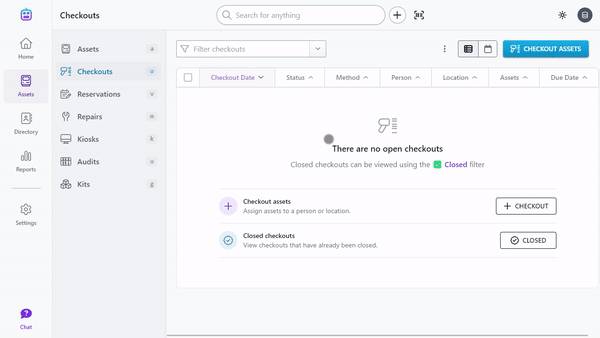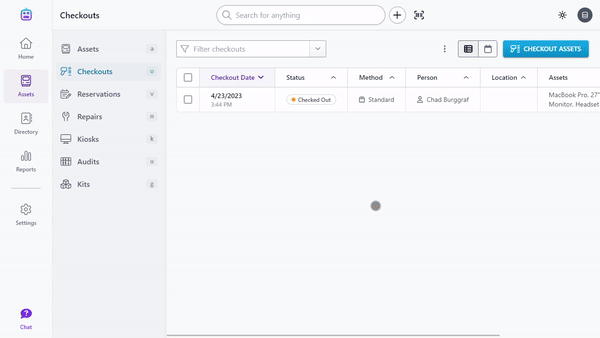Assigning Assets with Check-In and Checkout
One of the fundamentals of asset tracking is keeping a permanent, auditable record of responsibility over time. This is accomplished by checking out assets to someone who is responsible for them and checking them back in when they are returned.
A typical scenario is a new employee being onboarded and receiving a workstation: a laptop, a pair of monitors and a headset, for example. A new checkout is created in Assetbots assigning these assets to the employee. While checked out, the assets cannot be assigned to anyone else, so you are able to quickly discover who is responsible for them should you need to (e.g., to handle an expiring warranty or send in for repair).
Once the employee is no longer responsible for an asset you can check it back in. This releases the asset and makes it available again.
Checkouts are Living Records
Checkouts in Assetbots are not simply status labels like in many other tools. Instead, they are records that stay alive until all the assets in the checkout are checked back in. You can add notes and upload files to checkouts; search, filter and sort them; and navigate easily to their related assets, people and locations.
There are three important concepts to understand about how assets and checkouts are related in Assetbots:
- Assets can be checked out in bulk to a person, a location, or both.
- Checkouts can be partially checked in by having only some of their assets checked in.
- Assets can be checked in in bulk across many checkouts, and Assetbots will figure out which checkouts to leave open or to close automatically.
Bulk check-in is particularly interesting, as it enables the following common scenario: imagine you have a group of employees offboarding at the same time on a Friday afternoon. You receive a large group of assets all at once and they are all stacked in piles on the return counter.
Checkout by Searching
Start a new checkout by navigating to the checkout list and clicking Checkout Assets or by using the keyboard shortcut Shift+O. Use the Find assets search field to search for an asset to checkout.
Select one or more assets by clicking on it. Only assets available for checkout are selectable, and the current selection will be reflected in the counter at the bottom of the dialog.

Once you’ve made your selection, click Next. Choose whether you want to check the assets out to a person, a location, or both, and then select your checkout target(s) accordingly. Optionally enter a due date, choose a signature capture option, and enter any notes you’d like to attach to the checkout.
Finally, review your asset selection at the bottom of the dialog and click Checkout.
Checkout by Scanning
Start a new checkout by navigating to the checkout list and clicking Checkout Assets or by using the keyboard shortcut Shift+O. Click the Scan button to the right of the Find assets search field (indicated with a barcode icon) to start the scanner. Scan one or more assets to add them to the checkout.
The counter at the bottom of the dialog will increment each time an available asset is successfully scanned. Scanning an item that is unavailable will generate an error tone and blink a red indicator. Scanning an item that doesn’t exist will generate a prompt letting you add the asset.

If you prefer to use your external USB or Bluetooth scanner, simply start scanning once the Checkout Assets dialog is open. Each successful scan will add the asset to your pending checkout.
Check In by Searching
Start a new check-in by clicking the Add Something button in the top bar next to the Search for anything field. Choose Check-In from the list, or use the keyboard shortcut Shift+I. Use the Find assets search field to search for an asset to check in.
Select one or more assets by clicking on it. Only assets that are currently checked out are available, and the current selection will be reflected in the counter at the bottom of the dialog.

Once you’ve made your selection click Next. Optionally enter any notes you’d like to attach to the checkout, review your asset selection at the bottom and click Check In.
Check In by Scanning
Start a new check-in by clicking the Add Something button in the top bar next to the Search for anything field. Choose Check-In from the list or use the keyboard shortcut Shift+I. Click the Scan button to the right of the Find assets search field (indicated with a barcode icon) to start the scanner. Scan one or more assets to add them to the check-in.
The counter at the bottom of the dialog will increment each time a checked-out asset is successfully scanned. Scanning an item that is not checked-out will generate an error tone and blink a red indicator.

If you prefer to use your external USB or Bluetooth scanner, simply start scanning once the Check In Assets dialog is open. Each successful scan will add the asset to your pending check-in.
